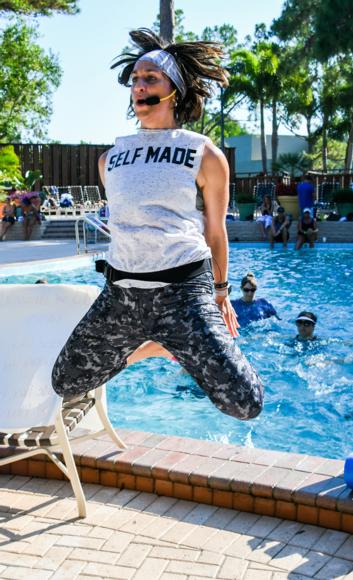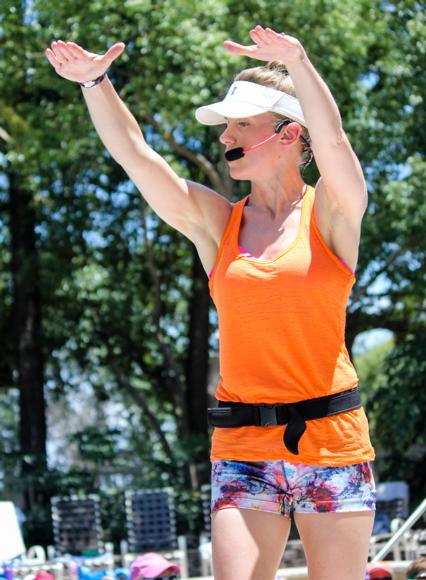Teaching from the pool deck
This is an excerpt from Aquatic Fitness Professional Manual-7th Edition by .
The AEA considers deck instruction as the preferred method of leading aquatic fitness in most situations. See the sidebar AEA Standards and Guidelines for Deck Instruction for more information.
Advantages
- You are highly visible to participants.
- You can use your whole body to provide visual cues.
- Often, but not always, you can be better heard from on deck.
- You have better visibility of your class. You can see what participants are doing. This is especially important if you are expected to be both lifeguard and instructor.See chapter 13 for AEA Standards and Guidelines for Aquatic Fitness Programming - Lifeguard recommendations.
- Some movements, because of their complexity, can be explained and demonstrated only from the deck where participants can see what your whole body is doing.
- Complex choreography is better explained and demonstrated from the deck.
- New participants can usually follow deck instruction best because the instructor is more visible.
- It is easier to change or adjust your music from the deck.
Disadvantages
- You are exposed to the elements (heat, humidity, sun, wind).
- You are leading from a hard surface without the support and buoyancy of the water.
- You increase your risk for injury caused by slipping or impact.
- Your participants might be in prolonged neck hyperextension looking up at you on deck.
- The tempo and execution of movements (air and gravity) must be altered to approximate water conditions (viscosity and buoyancy).
- It can be difficult to demonstrate movements unique to the water, such as suspended training, or high-impact options, including propelled moves.
AEA Standards and Guidelines for Aquatic Fitness Programming
Deck Instruction
The AEA recommends deck instruction as the preferred method of leading aquatic classes in most situations. Deck instruction provides the highest level of safety for the participants by allowing better observation and quicker response to emergency situations. Deck instruction also provides greater visibility of the aquatic fitness professional to the participant and the participant to the aquatic fitness professional. The AEA recommends that the aquatic fitness professional remain on deck when there is no additional lifeguard on duty, when there are new participants in the program, or when new movements are being demonstrated.
The safety of the aquatic fitness professional does not have to be compromised if proper precautions are taken. Suggestions for safe deck instruction include the following:
- Avoid high-impact movement demonstration.
- Use a chair for low-impact demonstrations and balance needs.
- Consider non-impact teaching techniques.
- Wear proper footwear for deck instruction.
- When available, use a teaching mat to reduce impact stress.
- Wear appropriate clothing for the environment in which you work.
- Drink sufficient water to stay hydrated and protect your voice.
- Use a microphone when available or incorporate non-verbal cues.
- Position the music source where it provides the least interference with vocal cueing.
- Use caution when utilizing any electrical source, including sound systems, near a pool due to potential hazard of electrical shock.
- Lead the workout rather than participate in the workout.
- Train for endurance, strength, flexibility, and balance within your personal workout program to assure the ability to perform safely on the deck.
Movement Execution and Weight Transfer
Safe and effective demonstration of impact options for various moves and combinations is one of the toughest challenges an instructor faces when teaching from the deck. On deck, the instructor needs to demonstrate grounded, propelled, and level I, II, and III movements at an appropriate tempo with gravity and without the benefits of buoyancy. Needless to say, this requires careful planning as well as the assistance of teaching tools, such as chairs, stools, and walls. Here, we discuss three deck instruction options: full impact, low impact, and non-impact.
Full (high) impact.
Many moves, such as jumping jacks, cross-country skis, jogs, knee lifts, kicks, turns, leaps, and rocks, can be demonstrated with full impact on deck (see figure 10.9). With modification to a slower tempo, full impact is most similar to the actual mechanics of the movement as it is to be performed in the water.

Figure 10.9 If a slower tempo is used, full impact instruction most closely resembles the actual exercise being taught.
Deck demonstration provides challenges that make full-impact instruction precarious. Most pool decks are made of a hard surface, such as concrete or tile, and might be slippery, especially when wet. Leading a class with full impact increases your risk for overuse and acute injuries. Most aquatic fitness professionals choose low-impact or non-impact demonstrations to save wear and tear on their musculoskeletal system. You can reduce slipping and impact stress by wearing a supportive pair of shoes and using a nonskid cushioned mat on deck. Full impact should be used only sparingly to demonstrate the first few repetitions of a movement, set a pace, or motivate the class.
Reduced (low) impact.
Reduced impact demonstration protects your musculoskeletal system when leading from the pool deck. It is often the preferred method of deck instruction for most movements because of its versatility and safety (figure 10.10). However, reduced impact demonstrations are not without challenges.

Figure 10.10 Reduced impact instructing from the deck is often the preferred method.
Since your actual demonstration might not show the intended impact level, you must otherwise cue participants immersed in the water to perform the desired impact. Consider the use of clear vocal cues, hand signals, or even printed signs (e.g., "jump", "propel", or, "tuck"). You might also refer to a participant in the pool with proper mechanics for others to observe and imitate.
Low-impact demonstrations can also challenge your balance skills. The use of a pole, wall, or chair for support can help with balance on deck. Maintaining a wide base of support (feet at shoulder width or slightly wider) and lowering your center of gravity (slight squat position) improves stability and balance and makes many movements easier to perform on deck at the appropriate tempo.
If you march on deck, participants will generally march in the pool. However, if you wanted them to jog in the water, your visual cue was not successful. The problem lies with your demonstration of weight transfer. Adjust your teaching technique while still keeping a low-impact option by quickly shifting the weight from one foot to the other, while enhancing your demonstration with exaggerated visual cues. Plantar flexing at the ankle and rolling from the ball of the foot to the heel to quickly shift weight from one foot to the next gives more of the appearance of jumping from foot to foot to perform a jogging motion. This technique helps motivate participants to perform the desired movement with proper intensity.
You may also incorporate a chair or stool for a low-impact teaching alternative. While seated, you can demonstrate one-footed and two-footed moves with less impact because most of your body weight is supported by the chair or stool, yet the feet do contact the pool deck with each move. The drawback is that participants may assume that the movement is at level II, even if the exercise should be performed at level I in the water. To make this more effective, add a verbal cue, a hand signal, or possibly even a cue card to clarify.
Learn more about Aquatic Fitness Professional Manual, Seventh Edition.
More Excerpts From Aquatic Fitness Professional Manual-7th EditionSHOP

Get the latest insights with regular newsletters, plus periodic product information and special insider offers.
JOIN NOW
Latest Posts
- Using double inclinometers to assess cervical flexion
- Trunk flexion manual muscle testing
- Using a goniometer to assess shoulder horizontal adduction
- Assessing shoulder flexion with manual muscle testing
- Sample mental health lesson plan of a skills-based approach
- Sample assessment worksheet for the skill of accessing valid and reliable resources


